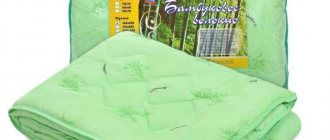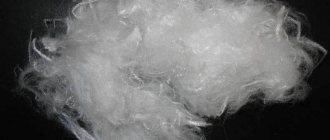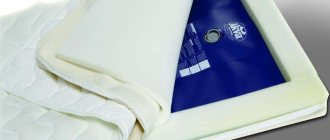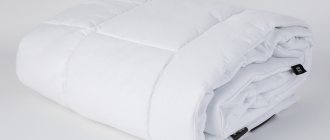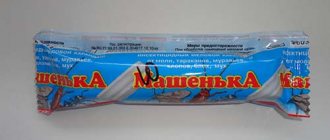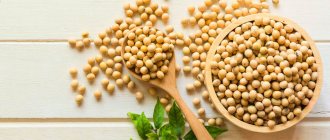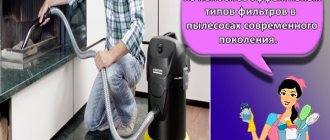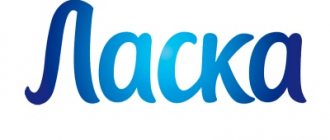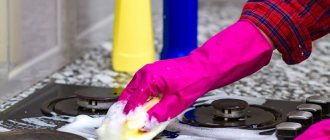Bamboo pillows: pros and cons, comparison with other fillings. Choosing a pillow.
The pillow is the assistant of Morpheus, who sends us to the kingdom of sleep and peace. A comfortable pillow is the key to a good night's sleep and well-being throughout the day. But isn’t it easier to develop a universal formula and produce exclusively one – a comfortable model of pillows? But everything here is not as simple as it might seem, because, depending on our physiological characteristics and habits since childhood, by the concept of a comfortable pillow we mean completely different things. In this article we will look at bamboo pillows, their advantages and disadvantages, and also compare them with other fillings.
Two ways to obtain raw materials for filler
Obtaining bamboo fabric varies in complexity, which consequently affects the cost.
- Mechanical method. By careful mechanical grinding, a fibrous mass is obtained from young bamboo stems, from which thin fibers up to 25 cm long are then extracted. Mechanical fiber is sometimes called bamboo linen; it is the most valuable. Linen has a porous structure and is more hygroscopic and elastic compared to viscose. The complexity of the process led to the high cost of the finished product obtained in this way.
- Chemical. Plants are crushed to the state of sawdust, and then, under the influence of chemical reagents (alkali and acid), they are converted into cellulose, from which, in turn, a thin viscose fiber is formed, similar to viscose from other plants, but retaining the basic qualities present in bamboo. Full automation of production, low price of materials and equipment made it possible to make the cost of production much lower than with traditional mechanical processing.
Despite the use of strong acids and alkalis in the chemical process, the fiber does not deteriorate its environmental properties, since these reagents are water-soluble and are completely removed during further processing, leaving no traces. Another plus is that the fiber used as a filler is not subjected to additional bleaching and dyeing procedures, that is, it contains exclusively natural material.
This is interesting: Buckwheat husk pillow: reviews of the pros and cons. Benefits of a pillow with buckwheat husks
What is a bamboo fiber pillow?
The concept of “bamboo”, which evokes associations with something tough and solid, is firmly rooted in our consciousness. So why is the pillow itself, light as feathers, almost airy? It's all about the bamboo fiber filler.
Mass production of this fiber began at the end of the last century. Its main supplier was China. It is there that the largest areas of growth of the giant frost-resistant Moso bamboo are up to 30 m high and the stem is up to 20 cm thick. Such a plant does not require care, fertilizers, or pest control products, therefore it is environmentally friendly. For processing, trunks no older than 4 years are used. The resulting cellulose fiber is fluffy, white, and many times stronger than viscose. It is used as a natural filler.
The cover can be made from various types of fabric: pure cotton (teak-luxury), a mixture of cotton and polyester (teak), synthetic (microfiber). The most expensive fabric is made from 100% mechanically produced bamboo fiber.
Articles on the topic (click to view)
- How to choose good quality bedding
- How to wash a cotton blanket
- Do I need to iron bed linen after purchasing or washing?
- Blanket sizes and standards
- How to wash a long pile blanket
- Bed sheet size: standard table
- How to wash terry towels
A pleasant surprise for the buyer will be the presence of a removable cover. Quilted from the inside with a layer of bamboo fiber, it:
- easy to remove;
- simply erased;
- dries quickly;
- withstands many washes.
The product is more expensive, but the costs are offset by the ease of care.
The pillow has a familiar shape and dimensions standard for Russian manufacturers: length 40 – 80 cm, width 30 – 50 cm. Euro size 40x80 is an oblong-shaped product.
Beneficial features
Bamboo fiber has a number of useful qualities, and their combination is unique among other fillers made from natural materials, not to mention synthetics:
- Hypoallergenic. Bamboo products rarely cause allergies;
- Hygroscopicity. They absorb moisture well and dry quickly;
- They have the perfect combination of softness and elasticity;
- Light weight. Synthetic products weigh much more;
- Low tendency to absorb odors;
- Breathability. You can breathe freely through a bamboo pillow;
- High durability, although less than that of good synthetic fillers;
- Easy to care for;
- Antiseptic properties. This quality of bamboo to suppress the vital activity of microorganisms has been identified and confirmed by numerous studies;
- Lack of opportunity for dust and feather mites or other microscopic organisms to inhabit and reproduce. Natural fluff ranks first in terms of mite content.
Hypoallergenic, mite-free and antiseptic properties make bamboo pillows most suitable for people suffering from asthma attacks.
Almost every review from owners of products made from bamboo fibers states that the pillows are comfortable and practical. And even if it’s a hot night, the absorbed sweat dries quickly, leaving no odor behind, confirming the antiseptic properties of the material.
Hypoallergenic, mite-free and antiseptic properties make bamboo pillows most suitable for people suffering from asthma attacks.
There are few negative sides. The downside is the wrinkleability of the filler, which is easily compensated for by regularly fluffing the pillow. Until recently, many were stopped by the cost of the material, since there was only a mechanical method for processing plant raw materials. As technology developed, the price dropped noticeably and removed bamboo from the category of exclusive materials, making it accessible to buyers of any income level.
The softness of the fiber makes it difficult to use in orthopedic products and therefore bamboo should be used with caution for diseases of the spine, especially for cervical osteochondrosis.
What it is
Bamboo pillows are a sleep accessory containing a product of processing plant raw materials. In appearance and to the touch it resembles cotton wool or padding polyester. The product belongs to artificial materials, but is made from natural raw materials.
Plant fibers consist of soft, porous, hollow threads that provide volume and softness to products. The accessories are very light due to their structure.
The filler is produced in two ways: mechanical and chemical.
In the mechanical method of obtaining the product, wood is crushed to obtain cellulose, from which fibers are formed. The process turns out to be very long, labor-intensive and therefore expensive. The product obtained as a result of the mechanical production method is also called “bamboo flax”.
The use of chemicals in its production speeds up the process and reduces the cost of the material. It is called "bamboo viscose".
Products from well-known manufacturers are supplied with certificates that confirm the safety of the material for the health of the buyer and the environment.
After chemical treatment, the product is purified. The finished products do not contain chemical residues and are not harmful to health.
How to obtain soft material
Initially, the production of bamboo fiber was only mechanical. The use of manual labor in this method makes it very expensive. Typically, such raw materials are labeled as “bamboo linen” - bamboo flax.
Later they began to use a chemical method, which made it possible to put production on stream. The cost of such material is much lower. At the same time, the manufacturing process itself is harmful only directly to workers, and the smell, along with chemicals, is completely washed out of the final product.
The technology for processing strong stems into soft fiber is reminiscent of the production of viscose. Young stems, up to 4 years old, are ground into shavings. Under the influence of high temperatures and special chemicals, it is transformed into a homogeneous substance, from which threads are then drawn.
Interesting!
From bamboo stems older than 5 years, charcoal bamboo fiber is made by burning them. It has an amazing property - it absorbs moisture while remaining dry. Most often, reusable diapers for children are made from this material.
The benefits and harms of bamboo fibers, expert opinion
Let's look at the pros and cons of bamboo pillows. To win the market, a new product must surpass the characteristics of an already favorite one, and bamboo pads are successfully edging out synthetic padding thanks to a lot of advantages:
- The fiber is not just hypoallergenic , it also has the ability to reduce allergies due to its unique composition, which is noted even by doctors
- Permeable , that is, they allow air to pass through without causing sweating.
- They are hygroscopic , instantly absorb moisture and dry quickly, which is very important in the hot summer season.
- The elastics hold their shape perfectly and have sufficient rigidity. Sleeping on such a pillow in the morning will not bring neck pain or problems with the spine.
- They are bactericidal ; mites cannot grow in bamboo viscose, and other pathogens will simply die if they enter the environment.
- Neutral , do not accumulate odors.
- Unpretentious , do not require dry cleaning, home conditions are quite sufficient.
- Durable and durable , they will fully recoup the investment.
- Affordable , not much more expensive than other varieties, within reason.
The disadvantages of a pillow with bamboo filling include its rapid wrinkling. The fibers gradually cake, air is forced out, and the pillow becomes not as comfortable as it was originally. Another disadvantage is the hygroscopicity of the material; if you use it in a too humid climate, the pad will become saturated like a sponge and will not have time to dry.
This problem can be corrected by regular fluffing, and down pillows also need to be adjusted regularly. But no amount of beating can bring synthetic winterizers back to life. If bamboo, after being “shaken,” is again voluminous and elastic, its synthetic counterparts systematically turn into pillows, not pillows.
Some sources present bamboo pillows as rejuvenating and improving the condition of the skin, but this already smacks of an advertising canard. If everything were so simple, why take care of your face, buy expensive products, and waste time. I bought a pillow with bamboo and everything is fine. But thanks to the absence of mites and dust in the fiber, the rashes and irritations that these mites cause can really go away.
It is almost impossible to find expert opinions specifically on the benefits of bamboo pillows; no one will take on such responsibility. However, it is known that bactericidal properties have been confirmed in laboratory conditions, as well as breathability.
Chair covers for the kitchen are made from different materials.
The bamboo roller blind can be hung using the instructions.
Advantages and disadvantages
Like other products, a bamboo filled pillow has its pros and cons. You need to pay attention to them when making a purchasing decision.
Pros.
- Hypoallergenic. The pillow is suitable for people suffering from allergies and asthma.
- Breathability. The filler does not accumulate or retain heat. This creates a feeling of coolness, which is especially pleasant during the hot season.
- Contains no animal-derived materials (important for vegans).
- It has no odor of its own and does not absorb environmental odors, unlike down and feathers.
- Environmentally friendly.
- Easy and inexpensive care, products can be washed in a washing machine.
Minuses:
- accessories filled with this viscose do not retain their shape well and quickly become compacted;
- increased hygroscopicity, the ability to quickly absorb moisture from the air;
- takes the shape of the body, does not provide neck support, which is not suitable for people with problems in this area;
- service life is from 1 to 3 years, which is much shorter in comparison with down and feather pillows.
Which filler is better to buy a pillow with: comparison of the most popular fillers
Of course, it is impossible to make a comprehensive review of bamboo pillows without comparing them with other popular fillings. We offer a comparison table with the main characteristics, after reading which you can make your final choice.
| Type of filler | Pillow characteristics |
| Feather pillow | Natural softest filler, which is preferred by many. But fluff can also act as an allergen, and it can also harbor “uninvited guests” in the form of mites and pathogenic organisms. Dry cleaning is recommended once a year. |
| Feather pillow | Natural hard filler, which is chosen by people with significant weight. An excellent option for those who like hard and elastic pillows. Care and requirements are the same as for down products. |
| Down and feather pillow | Average hardness, care and requirements, as for down fillers. |
| wool pillow | An excellent elastic option for those who strive for everything natural and do not want to sort out down and feathers once a year. But with a woolen pillow there is no less work - once a month it must be steamed so that the above-mentioned “guests” do not come. Another disadvantage of wool pillows is the accumulation of odors, which can only be gotten rid of in one way - proper washing. |
| Pillows made of padding polyester, holofiber, etc. | An excellent budget option that does not cause allergies, is cheap and requires minimal care - just machine wash. The downside is that they quickly get lost and thus wear out. |
| Silk pillows | And here we are talking about the filler. Twisted silk fills the pillows and creates unique comfort while sleeping. The disadvantages are both the fabulous price and difficult care. |
| Buckwheat husk pillows | A great solution for those who love (or need) rigidity, while sleeping so soundly that the rustling of the husk when turning over is an insignificant detail. It is considered an orthopedic solution with a massage effect, but experts say that this is just advertising, because husk cannot properly support the body, like other natural fillers. |
| Cotton pillow | An excellent option only for hospitals and sanatoriums that require “frying” after each client. Apparently it was not designed to be convenient. |
| Orthopedic foam pillow | This is the best solution for orthopedic problems; it is she, and no other, that keeps the back in the correct position. There is only one minus - even those for whom it is acutely indicated take a long and painful time to get used to it. There are only a few people who fell asleep on it from the first moment. |
| Bamboo pillows | Natural fibers create medium stiffness, are hypoallergenic on the one hand, and do not allow animals to grow on the other hand. And of course the budget price, which attracts many people. |
When buying a pillow, pay attention to the following factors:
- Naturalness of materials;
- Hypoallergenic (especially if there are children and allergy sufferers in the family);
- Pillow hardness;
- Orthopedic properties (as we have already found out, only hard foam pillows have them);
- Value for money and durability.
This way, you will approach the purchase of a pillow consciously.
This is interesting: Duck down pillows: properties, pros and cons, how to care
Product dimensions
Manufacturers offer a wide range of sizes of bamboo pillows. According to the generally accepted standard, the smallest ones are 40x40 in size and are perfect for a child. For lovers of everything modern, you can always choose a “European standard” pillow with a size of 50x70 cm. There are also pillows 70x70, large, soft and very comfortable. When choosing the optimal pillow size, it is important to take into account not only the standard parameters, but also its height. For people with broad shoulders, a product height of 12-15 cm is suitable, while a slightly lower height is recommended for children and women.
Care instructions
Bamboo pillows do not require specific care, but it is important to follow some rules to extend their service life:
- Can only be washed together with the cover on a delicate wash cycle;
- Water temperature no more than 40 degrees;
- An additional rinsing mode is required, since the remains of detergents, washing powder or conditioner will negate all the environmental qualities of the material;
- Do not use any bleaches, whether they contain chlorine or oxygen; Dry only on a horizontal surface, avoiding direct sunlight;
- Shake thoroughly before use.
Compliance with the last point is important not only after washing. It is advisable to fluff the pillow both before and after bedtime to avoid caking.
Long-term use of bamboo pillows, care issues
The issue of product durability directly depends on the composition of the filler. When combining bamboo fiber with a small addition of synthetics, the product will lose its shape and basic elasticity within a year. If the “natural material” is made up of conventional polyester fiber, padding polyester or comforter, then the pillow will last, on average, up to three years. Such things do not impose strict requirements for their care, but it is advisable not to violate the manufacturer’s recommendations. Read more about polyester fiber in this article. In general, maintenance procedures have the following requirements:
- washing is carried out directly in the cover with a gentle cycle;
- liquid detergents are used;
- the temperature is set to no more than 40°C;
- Various bleaches are prohibited;
- After washing, turn on the rinse cycle;
- Before each new use, you should thoroughly shake the product.
Bamboo pillows
In any case, the comfort of a pillow can only be determined in practice to ensure the physical comfort of sleep. How to choose a pillow is quite an interesting question. The product must be sufficiently elastic to maintain the correct position of the head and maintain the required blood circulation to the brain in a supine position. Read more about how to choose a pillow in this article. It is impossible to predict in advance which filler is best suited - holofiber, Thinsulate or bamboo, given the large number of manufacturers. Even 100% natural bamboo will not be comfortable for everyone: such pillows are excessively soft, which, sooner or later, will lead to severe pain in the neck. As a result, the required product package must be selected either based on reviews from previous customers, or by manually searching through several options in one’s own practice. For example, an interesting article about holofiber is available on this page.
Comparison of bamboo fiber with other fillers
Today there is a huge selection of pillows with various fillings on the market. The most popular: down/feather, holofiber, bamboo, and a little less often silk and eucalyptus.
It's easier to make the right choice when you understand what's best. The following table will clearly show the features of each material and help you understand everything:
| Filler | Feather | Holofiber | Bamboo | Silk | Eucalyptus |
| Properties | |||||
| Hygroscopicity | Yes | Yes | Yes | Yes | Yes |
| Breathability | Yes | Yes | Yes | Yes | Yes |
| Hypoallergenic | No | Low | Yes | Yes | Yes |
| How to wash | Can't be washed | Delicate mode, at a temperature of no more than 40 degrees | Delicate mode, at a temperature of no more than 40 degrees | Delicate mode, at a temperature of no more than 30 degrees or hand wash | Delicate mode, at a temperature of no more than 30 degrees or hand wash |
| How to dry | Once every 2 weeks in the sun | On a horizontal surface, avoiding direct sunlight | On a horizontal surface, avoiding direct sunlight | On a horizontal surface, avoiding direct sunlight | On a horizontal surface, avoiding direct sunlight |
| Saving the form | Yes | No | Yes | Yes | Yes |
| Life time | 5-20 years | Up to 5 years | 1-3 years | 10-15 years | 5-15 years |
| Price (in rubles) | 500-3 000 | 600-1 500 | 500-3 000 | 2 000-15 000 | 1 200-7 000 |
For your information! Prices and service life are indicated in the table approximately. Because each seller sets his own prices for his products. And the service life depends on the quality of the raw materials used and proper care.
The table shows that the most durable and best-performing fillers (silk and eucalyptus) have a fairly high price. Bamboo pillows are not inferior in characteristics, but have an optimal cost, and therefore are the best.
Product selection criteria
When choosing new products, you want to know the pros and cons of bamboo pillows and reviews about them. Housewives choose things so that they are beautiful, comfortable, and of high quality. When choosing a product, you need to be careful, because often uncertified products appear on store shelves. Before purchasing an item, you should consider in detail its characteristics, what material it is made of, and whose production. Then the label on the product is carefully examined. If the product is of high quality, then the filler contains only bamboo, linen or bamboo viscose. Synthetic additives are allowed in minimal quantities.
After the label, you need to pay attention to the quality of the seams. On good products they are smooth, strong, without gaps. If you do not pay attention to this indicator, then after some time of using the pillow, the filling will begin to fall out of the cracks between the seams.
Bamboo is a breathable material , so oxygen passes through the product well. If air has difficulty passing through the fabric, then it is a fake. A bamboo pillow cannot be cheap. High cost is considered an indicator of the high quality of the item. Before purchasing, many consumers check with consultants whether bamboo fiber is synthetic or not. A knowledgeable seller will never call bamboo material synthetic.
Proper care: can it be washed?
Although bamboo pillows are quite easy to care for, you still need to remember the basic recommendations:
- washing should be carried out at temperatures up to 40 degrees, without bleaches, preferably with a liquid detergent and in a mode with additional rinsing;
- It is better to dry in a horizontal position so that the filler is distributed evenly throughout the cover and does not bunch up in one direction;
- After washing (and periodically during use), the pillow must be fluffed.
Information sources:
- : Study of the properties of materials obtained from bamboo fiber - Ph.D. Ivantsova T. M., Federal State Budgetary Educational Institution of Higher Professional Education "Omsk GIS".
- Bio
- Latest Posts
Position : editor-in-chief. About me : Generalist specialist. Experience as an editor and author of articles as a journalist for more than 12 years. He graduated from the Faculty of Philology of the Belarusian State University (Department of Russian Language and Literature) and received a diploma in the specialty “Philology. Teacher of Russian language and literature."
- How to choose a recorder: comparison of models and characteristics - 12/25/2019
- Which stand mixer to choose: TOP 5 best models - 12/23/2019
- How to choose a cast iron frying pan: buying tips - 12/21/2019
Rating
| Name | Filler | Height | Hardness degree | Prices, rub |
| Green Line Bamboo (165993) | Bamboo fiber 50%, polyester 50% | average | from 721 to 788 | |
| AlViTek Bamboo (PUB-050) | bamboo fiber+PE | average | from 815 to 1335 | |
| Natures Bamboo Stem 50 | bamboo fiber is fixed in a quilted cover, inside is highly siliconized microfiber. | regulated | elastic | 1547 |
| Sortex Natura Bamboo, quilted (367-512) | Bamboo fiber, Siliconized fiber | 10 | average | from 1035 to 1821 |
| Pillow Light Dreams 'Bamboo' | Bamboo fiber, Bamboo | 12 | average | from 937 to 1180 |
Green Line Bamboo (165993) 70 x 70 cm
Filler:
- bamboo fiber 50%
- polyester 50%
Elasticity: average Prices: from 721 to 788 rubles. Advantages: does not clump Disadvantages: sore neck
AlViTek Bamboo (PUB-050) 50 x 70 cm
Filling: bamboo fiber + PE Elasticity: average Prices: from 815 to 1335 rubles. Advantages:
- Soft
- Keeps its shape well
- Washable
- Good support
Disadvantages: no
Natures Bamboo Stem 50
Filling: bamboo fiber fixed in a quilted cover, inside highly siliconized microfiber Height: adjustable Elasticity: elastic Prices: 1547 rub. Advantages:
- Elastic
- Soft
- Sleep comfortably
- Can be adjusted in height and elasticity
- Keeps its shape
Disadvantages: no
Sortex Natura Bamboo, quilted (367-512) 68 x 68 cm
Filler:
- Bamboo fiber
- Siliconized fiber
Height: 10 cm Elasticity: average Prices: from 1035 to 1821 rub. Advantages:
- Doesn't clump
- Convenient
- Hypoallergenic
- Washable
Flaws:
- The napkin is shedding
- High
- Uncomfortable sleeping on your side
